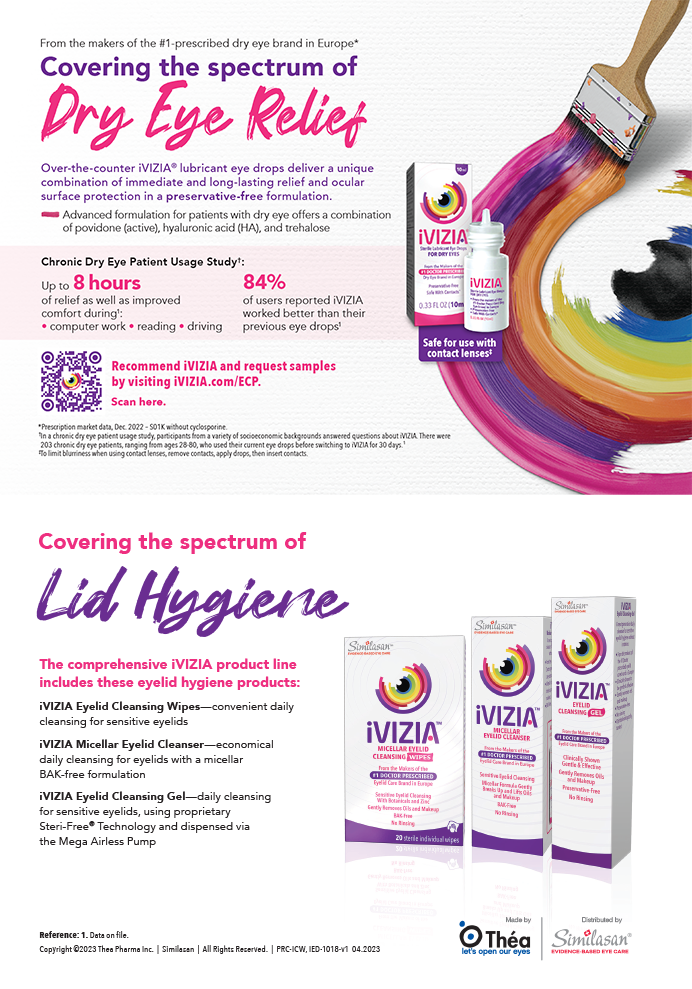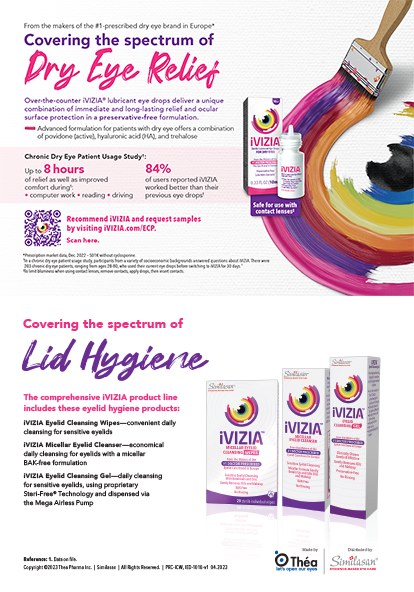Considerable advances have been made in the last decade in anterior segment diagnostic tools. Corneal topographers, for one, are now common in clinical practice, because the devices provide information that is essential for the detection of corneal abnormalities such as keratoconus. The color-coded contour map that shows the distribution of powers across the cornea's front surface is the first step in differentiating a normal from an abnormal condition. Like a fingerprint, however, individual corneal topographies are unique. Knowing when these variations fall outside of the norm and how they impact vision depends on quantitative indices derived from corneal topographic data.
CLINICAL PERSPECTIVE
Although corneal topography greatly facilitates the clinical diagnosis of keratoconus, it is important to remember that some patients who have a genetic predisposition to keratoconus will not have detectable disease at the time of refractive surgery. Even a careful examination of their family history may not reveal their propensity for the condition. In a recent study, several patients without any known risk factors for ectasia developed the pathologic condition after LASIK.1 Clearly, there is more to learn.
The diagnosis of forme fruste keratoconus (FFKC) relies almost entirely on an interpretation of corneal topographic analysis. Clinicians may use several other terms for FFKC such as keratoconus suspect or subclinical keratoconus, but their meaning is the same: except for corneal topographic findings and possibly some scissoring of the light reflex on retinoscopy, there are no other detectable, traditional signs that are present with true clinical keratoconus.
Topographic patterns to help diagnose keratoconus suspects that have been described in the literature include abnormal localized steepening (usually inferior, but it can be central or superior as well), asymmetric bowties, and bowties with skewed radial axes.2 Many ophthalmologists feel that there is little conclusive scientific evidence that using several available corneal topographic indices will lead to a firm diagnosis. Indices such as the steepest K reading, central and peripheral preoperative pachymetry, and the Rabinowitz inferior-superior value, however, are supported in the literature3 and should be considered within the clinical picture. Nevertheless, it is important to realize that there are no magic numbers; each case must be considered on its own merit and with an integrative evaluation of all the available clinical data.
USING THE INDICES
Of real benefit would be a computerized indication of the variation of a given value from the mean in a normal population and the statistical significance of that deviation based on published scientific data from a controlled clinical trial. Prospective studies are lacking on the detection of keratoconus and other abnormalities. Such research would provide guidelines that could be updated based on clinical experience.
Some corneal topographers provide color-coded indices to alert the physician when a particular variable is abnormal. The Humphrey Pathfinder (Carl Zeiss Meditec, Inc., Dublin, CA), Corneal Navigator (Nidek, Inc., Fremont, CA), and Tomey Keratoconus Screening (Tomey Corporation, Nagoya, Japan) corneal topographers use green to signify normalcy, yellow (caution) if the variable is two-to-three standard deviations from the normal mean, and red (clearly abnormal) if an index is more than three standard deviations from the normal mean (Figures 1 to 3).
Individual indices derived from corneal topography have specific purposes. For example, the averages of the central corneal power over the apparent entrance pupil are available on the Eyesys (Eyesys Technologies, Inc., Houston, TX), Nidek, and Tomey topographers. Clinicians may use this information to obtain accurate central keratometric (K) readings for IOL calculations. Most corneal topographers provide simulated K readings. Normal corneas should have simulated K reading of around 42.75 ?1.60D (standard deviation); K readings that are lower than 38.00D or greater than 47.50D would be more than three standard deviations from the mean. By itself, a K reading higher than this range is not diagnostic of keratoconus or another disease, and clinicians must take into account pachymetry and topographic patterns. Corneas with K readings of 48.00 to 50.00D, which are otherwise normal, have been associated with eyes that also have shorter axial lengths.
If clinicians note asymmetry on the topography, they can estimate manually the gradient in power, a rough estimate of the Rabinowitz inferior/superior gradient. For example, if the dioptric value along a 3-mm superior arc less the dioptric value along a 3-mm inferior arc is > 1.40D and < 1.90D, then the cornea may be suspicious for keratoconus. If the gradient is > 1.90D, then it may qualify as clinical keratoconus. Although this test is not very specific, it can provide some guidance on distinguishing between normal and abnormal topography. Alternatively, the inferior/superior index is calculated by a number of different corneal topographers that include the Eyesys and the Nidek systems.
More sophisticated methods combine the use of many topographically derived indices and artificial intelligence approaches to screen for keratoconus suspects. Several classification schemes are available on corneal topographers to assist in differentiating keratoconus suspects from patients with normal variations in corneal topography. In general, these methods rely on techniques of discrimination in conjunction with examples of normal corneal topographies as well as corneal topographies classified as keratoconus suspects. These techniques include the original Rabinowitz criteria with indices such as inferior/superior index, maximum K readings, and skewed radial axes that are intended to capture the essential features of keratoconus.4 Other examples include the Tomey Keratoconus Screening software (Figure 1), the Humphrey Pathfinder (Figure 2), and the Nidek Corneal Navigator (Figure 3).5-7 Although each of these tests is capable of estimating the likelihood of a given topography's being consistent with keratoconus suspects (or another corneal condition), it is essential for clinicians to realize that none is 100 specific, sensitive, or accurate. Practitioners must interpret the diagnostic information provided by the corneal topographer within the context of all the available clinical information.
CONCLUSION
Clinicians should use the indices for diagnosing keratoconic patients or keratoconus suspects only after the patients have discontinued wearing contact lenses for long enough to reverse or at least stabilize all corneal molding. The corneal topography of the average soft contact lens wearer with spectacle blurring can require several weeks to stabilize completely.8 Physicians may need to repeat the measurements of visual acuity, manifest refraction, and topography every 2 to 3 weeks until these values have stabilized before using topographic indices for planning laser vision correction or cataract surgery.
This work was supported in part by US Public Health Service grants EY03311 and EY02377 from the National Eye Institute, National Institutes of Health.
Stephen D. Klyce, PhD, is a Professor of Ophthalmology and Anatomy/Cell Biology at the Louisiana State University Health Sciences Center in New Orleans. He is a paid consultant to Nidek, Inc. Dr. Klyce may be reached at sklyce@klyce.com.
Marguerite McDonald, MD, is Clinical Professor of Ophthalmology at Tulane University School of Medicine in New Orleans, and is in private practice at the Ophthalmic Consultants of Long Island, Lynbrook, NY. She acknowledged no financial interest in the companies or products mentioned herein. Dr. McDonald may be reached at margueritemcdmd@aol.com.
Stephen G. Slade, MD, is in private practice in Houston. He acknowledged no financial interest in the companies or products mentioned herein. Dr. Slade may be reached at (713) 626-5544; sgs@visiontexas.com.


